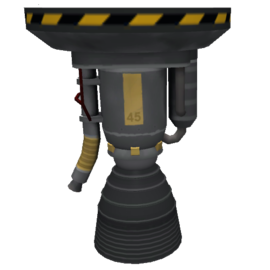Difference between revisions of "LV-T45 "Swivel" Liquid Fuel Engine"
m |
m (Updated information) |
||
| Line 2: | Line 2: | ||
The '''LV-T45 "Swivel" Liquid Fuel Engine''' is an engine which requires fuel from external liquid fuel tanks, and must be either connected beneath them or be on the receiving end of a fuel line. | The '''LV-T45 "Swivel" Liquid Fuel Engine''' is an engine which requires fuel from external liquid fuel tanks, and must be either connected beneath them or be on the receiving end of a fuel line. | ||
| + | |||
| + | It is similar in appearance to the [http://www.astronautix.com/engines/rs56osa.htm RS-56-OSA] core sustainer engine used by the late [https://en.wikipedia.org/wiki/Atlas_II Atlas II] rocket. | ||
== Usage == | == Usage == | ||
Revision as of 03:52, 20 September 2015
| LV-T45 "Swivel" Liquid Fuel Engine | ||
| Liquid fuel engine by Jebediah Kerman's Junkyard and Spacecraft Parts Co | ||
| Radial size | Small | |
| Cost | (total) | 1 200.00 |
| Mass | (total) | 1.500 t |
| Drag | 0.2 | |
| Max. Temp. | 2000 K | |
| Impact Tolerance | 7 m/s | |
| Research | | |
| Unlock cost | 3 500 | |
| Since version | 0.12 | |
| Part configuration | liquidEngineLV-T45_v2.cfg | |
| Maximum thrust | (1 atm) | 167.97 kN |
| (vacuum) | 215.00 kN | |
| Isp | (1 atm) | 250 s |
| (vacuum) | 320 s | |
| Fuel consumption | 13.70 | |
| Thrust vectoring | 3 ° | |
| Electricity generated | 6.0 ⚡/s | |
| Testing Environments | ||
| On the surface | Yes | |
| In the ocean | Yes | |
| On the launchpad | Yes | |
| In the atmosphere | Yes | |
| Sub-orbital | Yes | |
| In an orbit | Yes | |
| On an escape | Yes | |
| Docked | No | |
| Test by staging | Yes | |
| Manually testable | Yes | |
| Packed volume | None | |
The LV-T45 "Swivel" Liquid Fuel Engine is an engine which requires fuel from external liquid fuel tanks, and must be either connected beneath them or be on the receiving end of a fuel line.
It is similar in appearance to the RS-56-OSA core sustainer engine used by the late Atlas II rocket.
Usage
The LV-T45 is similar to the LV-T30 Liquid Fuel Engine, but with a slightly smaller thrust chamber, higher expansion ratio, and thrust vector control. Its slightly reduced thrust and considerably increased mass reduces its specific thrust, making it less suitable for first stages. It is best suited in second stages and the core stage of parallel lift-off configurations, where longer operating times and higher altitudes bring out this engine's advantage in specific impulse.
There are two excellent applications of this engine: in the core stage of parallel booster configurations, where its thrust vector control allows active control of a vehicle powered chiefly by LV-T30 or BACC Thumper solid boosters for lift-off, followed by the LV-T45 engine(s) continuing to operate after the strap-on stages have depleted and separated. And in the second stage of an aerodynamically stabilized booster started aloft using a suitable solid motor stage where the operation of the first stage is controlled by reaction wheels or the first stage burns out prior to the commencement of the gravity turn.
Product description
| “ | The LV-T45 engine was considered a breakthrough in the LV-T series due to its Thrust Vectoring feature. The LV-T45 can deflect its thrust to aid in craft control. All these added mechanics however, make for a slightly smaller and heavier engine in comparison with other LV-T models. — Jebediah Kerman's Junkyard and Spacecraft Parts Co |
” |
Changes
- Isp decreased from 370 s (vacuum) / 320 s (1 atm) to 320 s (vacuum) / 270 s (1 atm)
- Gimbal range increased from 1° to 3°
- Cost increased from 950 to 1200
- Electricity production increased to 6.0
- New model and texture
- Alternator added, engine now gains 1.0 electricity
- Major CFG revision (most notably Isp added)
- Initial Release

